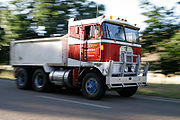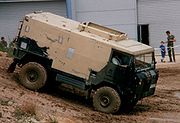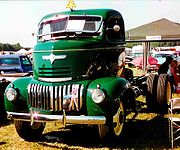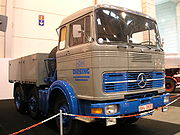
Cab over
Encyclopedia


Truck
A truck or lorry is a motor vehicle designed to transport cargo. Trucks vary greatly in size, power, and configuration, with the smallest being mechanically similar to an automobile...
or van
Van
A van is a kind of vehicle used for transporting goods or groups of people.In British English usage, it can be either specially designed or based on a saloon or sedan car, the latter type often including derivatives with open backs...
that has a vertical front or "flat face", with the cab
Cabin (truck)
The cab of a truck is an enclosed space in a truck where the driver is seated. The word originated as a short form of cabriolet, not cabin. Some may refer to the tractor unit of a semi-trailer truck as a cab, but this is not the subject of this article...
of the truck sitting above the front axle
Axle
An axle is a central shaft for a rotating wheel or gear. On wheeled vehicles, the axle may be fixed to the wheels, rotating with them, or fixed to its surroundings, with the wheels rotating around the axle. In the former case, bearings or bushings are provided at the mounting points where the axle...
. This truck configuration is currently common among Europe
Europe
Europe is, by convention, one of the world's seven continents. Comprising the westernmost peninsula of Eurasia, Europe is generally 'divided' from Asia to its east by the watershed divides of the Ural and Caucasus Mountains, the Ural River, the Caspian and Black Seas, and the waterways connecting...
an and Japan
Japan
Japan is an island nation in East Asia. Located in the Pacific Ocean, it lies to the east of the Sea of Japan, China, North Korea, South Korea and Russia, stretching from the Sea of Okhotsk in the north to the East China Sea and Taiwan in the south...
ese truck manufacturers, because the laws governing overall vehicle lengths are strict and the body style allows longer trailers or a longer cargo area for the same overall length.
Although popular among United States
United States
The United States of America is a federal constitutional republic comprising fifty states and a federal district...
heavy truckers and trucking companies during the 1970s because of strict length laws in many states, when those length laws were repealed, most heavy-truck makers moved to other body styles. It is, however, still very popular in the light- and medium-duty truck segment, with models such as the Isuzu
Isuzu
, is a Japanese car, commercial vehicle and heavy truck manufacturing company, headquartered in Tokyo. In 2005, Isuzu became the world's largest manufacturer of medium to heavy duty trucks. It has assembly and manufacturing plants in the Japanese city of Fujisawa, as well as in the prefectures...
NPR series or the Mitsubishi Fuso FE and FK/FM series.
Most Japan
Japan
Japan is an island nation in East Asia. Located in the Pacific Ocean, it lies to the east of the Sea of Japan, China, North Korea, South Korea and Russia, stretching from the Sea of Okhotsk in the north to the East China Sea and Taiwan in the south...
ese minivan
Minivan
Minivan is a type of van designed for personal use. Minivans are typically either two-box or one box designs for maximum interior volume – and are taller than a sedan, hatchback, or a station wagon....
s like the Suzuki Carry
Suzuki Carry
The Suzuki Carry is a kei truck produced by the Japanese automaker Suzuki. The microvan version was originally called the Carry van until 1982 when the van was renamed as the '...
, Toyota Hiace
Toyota Hiace
The Toyota HiAce is a motor vehicle produced by the Japanese manufacturer Toyota. First launched in 1967, the HiAce has since been available in a wide range of configurations, including minivan and minibus, van, pick-up, taxi, and ambulance....
and Mitsubishi Delica
Mitsubishi Delica
The Mitsubishi Delica is a range of trucks and multi-purpose vehicles built by Mitsubishi Motors since 1968. It was originally based on a small pickup truck introduced the previous year, also called the Delica, its name a contraction of the English language phrase Delivery car...
also use this body layout. It was also used for the (rear engined) Volkswagen Type 2
Volkswagen Type 2
The Volkswagen Type 2, officially known as the Transporter or Kombi informally as Bus or Camper , was a panel van introduced in 1950 by German automaker Volkswagen as its second car model – following and initially deriving from Volkswagen's first model, the Type 1 , it was given the factory...
van, and in military vehicles such as the Land Rover 101 Forward Control
Land Rover 101 Forward Control
thumb|right|300px|Side View.The 101 Forward Control was a vehicle produced by Land Rover for the British Army.-History:The vehicle was primarily produced to meet the Army's requirement for a gun tractor, and was designed to tow a field gun with a ton of ammunition and other equipment in the rear...
and the Pinzgauer High Mobility All-Terrain Vehicle
Pinzgauer High Mobility All-Terrain Vehicle
The Pinzgauer is a family of high-mobility all-terrain 4WD and 6WD military utility vehicles. They were manufactured in Guildford, Surrey, United Kingdom, by BAE Systems Land & Armaments. The vehicle was originally developed in the late 1960s by Steyr-Daimler-Puch of Graz, Austria, and was named...
.
History

Wisconsin
Wisconsin is a U.S. state located in the north-central United States and is part of the Midwest. It is bordered by Minnesota to the west, Iowa to the southwest, Illinois to the south, Lake Michigan to the east, Michigan to the northeast, and Lake Superior to the north. Wisconsin's capital is...
produced cab-over trucks as early as 1907, though by 1914 only their seven-ton model was a cab-over. They reintroduced the cab-over layout in 1933 with their "Camel Back" model, which allowed the cab to be tilted to access the engine.
The introduction of the first modern cab-over layout in the U.S. is credited to industrial designer Viktor Schreckengost
Viktor Schreckengost
Viktor Schreckengost was a noted American industrial designer and teacher, sculptor, and artist. His wide-ranging work included noted pottery designs, industrial design, bicycle design and seminal research on radar feedback...
, who with engineer Ray Spiller designed a cab-over truck for the White Motor Company
White Motor Company
White Motor Company was an American automobile and truck manufacturer from 1900 until 1980. The company also produced bicycles, roller skates, automatic lathes, and sewing machines. Before World War II, the company was based in Cleveland, Ohio.-History:...
in 1932.
The laws of the time limited truck length to 42 feet (12.8 m) on highways. Sitting the cab over the engine saved several feet of cab length, which was added to the trailer capacity. Schreckengost patented the design in 1934.
White-Freightliner
Freightliner Trucks
Freightliner Trucks is an American manufacturer of heavy duty trucks, chassis and semi-trailer trucks in the United States. The company was founded as Freightliner Inc in 1942 and is now a division of Daimler Trucks North America, a subsidiary of the German Daimler AG...
introduced its first tilting cab-over design in 1958, which allowed the entire cab to tilt forward for access to the engine.
Advantages

Wheelbase
In both road and rail vehicles, the wheelbase is the distance between the centers of the front and rear wheels.- Road :In automobiles, the wheelbase is the horizontal distance between the center of the front wheel and the center of the rear wheel...
to be shorter than in the conventional
Conventional truck
A conventional truck is a type of truck with its engine in front of the driver , as opposed to underneath with no nose like in a cab over. This model is the most popular for American truckers. The design gives the driver more leg room and a smoother ride. These models of semi-trucks hold their...
arrangement, wherein the engine is placed in front of the cab, covered by a horizontal or sloping hood that opens to allow engine access. Its shorter wheelbase allows cab-over semi truck
Semi-trailer truck
A semi-trailer truck, also known as a semi, tractor-trailer, or articulated truck or articulated lorry, is an articulated vehicle consisting of a towing engine , and a semi-trailer A semi-trailer truck, also known as a semi, tractor-trailer, or (in the United Kingdom and Ireland) articulated truck...
s to have a shorter overall length, thereby allowing for longer trailer
Trailer (vehicle)
A trailer is generally an unpowered vehicle pulled by a powered vehicle. Commonly, the term trailer refers to such vehicles used for transport of goods and materials....
s to be used. For light- and medium-duty solid- or rigid-axle trucks, the cab-over design requires less length for the cab and engine, in a given wheelbase, and therefore allows a greater length for the truck body or load area.
In both class 8 tractors and light- and medium-duty solid-axle trucks, the cab-over-engine design gives the COE model an advantage in maneuverability over a conventional model. And since COEs are generally lighter than conventionals, they can often haul heavier loads, given equal GVWRs (gross vehicle weight rating) and GCWRs (gross combination weight rating). Despite the COE designs' being smaller in general, over-the-road tractors can still be fully equipped with single or bunk beds. Also, lack of a hood gives better visibility to the driver, a tighter turning radius and significantly reduces the forward blind spots.
Blind spot (automobile)
A blind spot in a vehicle is an area around the vehicle that cannot be directly observed by the driver while at the controls, under existing circumstances...
Disadvantages
Some drivers have complained, however, that the shorter wheelbase in the COE semi-trucks gives a rougher ride than those with conventional cabs, as the driver's seat is above the front axleAxle
An axle is a central shaft for a rotating wheel or gear. On wheeled vehicles, the axle may be fixed to the wheels, rotating with them, or fixed to its surroundings, with the wheels rotating around the axle. In the former case, bearings or bushings are provided at the mounting points where the axle...
; and that the cabs tend to be noisier because the engine is directly below, though some of this is dependent on the amount of noise-dampening insulation used in the construction of the individual vehicle.
Because of their flat front design, early COE semi-trucks had significantly worse aerodynamics than conventional tractors. Modern cab-over designs, in both semi-trucks and light- and medium-duty models, have improved aerodynamics significantly over early models, but often still have higher drag coefficients than their modern conventional-design counterparts. This works against fuel economy, and offsets some of the improvement in fuel consumption garnered from the lighter weight of the cab-over truck when running less than fully loaded.
Although the tilting cab gives comparatively unobstructed access to the engine, its deployment causes unsecured items in the cab and sleeper (if equipped) to fall onto the windshield or under the instrument panel.

